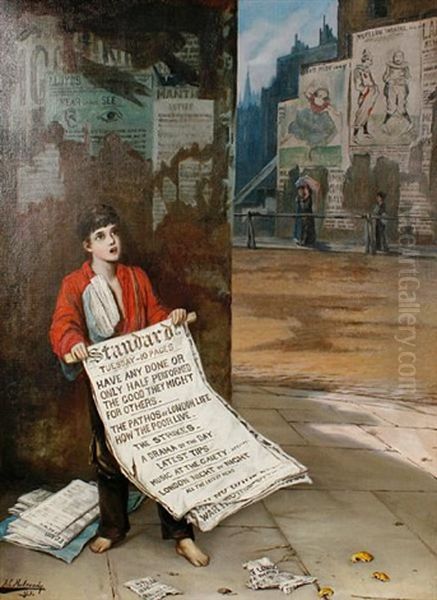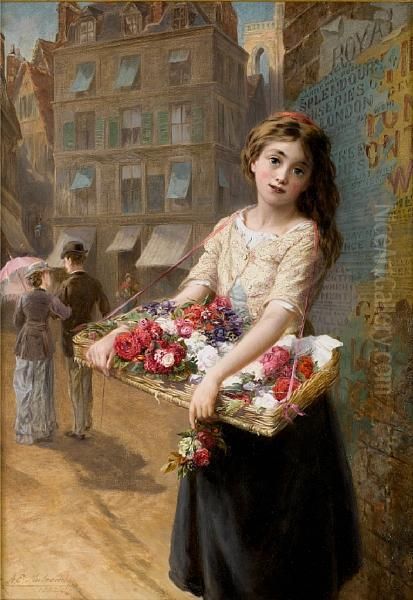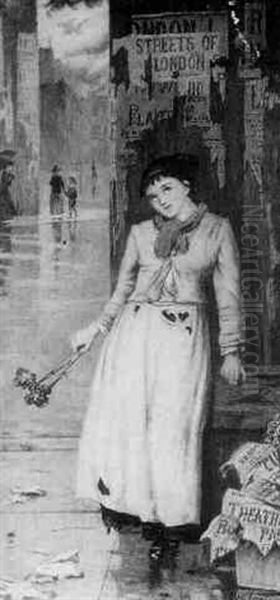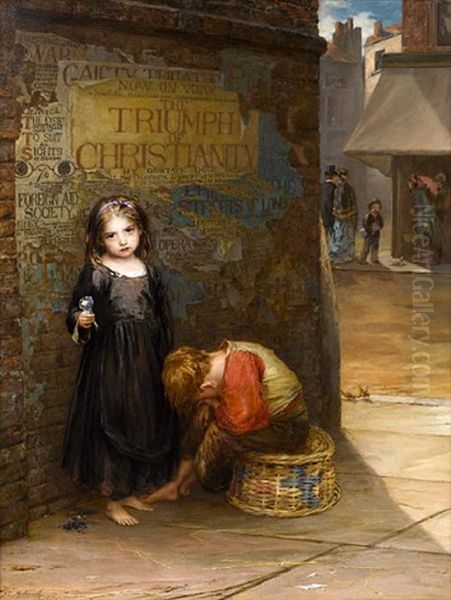Augustus Edwin Mulready stands as a poignant visual commentator on the complexities and hardships of life in Victorian London. Active during the latter half of the 19th century, he dedicated his artistic career primarily to depicting the lives of the urban poor, particularly the children and young adults navigating the city's unforgiving streets. Though perhaps less universally acclaimed than his famous grandfather, William Mulready RA, Augustus Edwin carved a distinct niche for himself within the British art scene, offering compelling, often critical, glimpses into the social fabric of his time. His work resonates with a particular sensitivity towards those on the margins, making him a significant figure in the tradition of British social realist painting.
Early Life and Artistic Heritage
Born in London around 1844, Augustus Edwin Mulready entered a world already steeped in artistic tradition. His grandfather, William Mulready (1786-1863), was a highly respected and successful Irish-born painter, a member of the Royal Academy, renowned for his meticulously crafted genre scenes and contributions to postal stationery design (the Mulready envelope). The artistic inclination extended further within the family; Augustus Edwin's mother and grandmother were also recorded as artists, creating an environment where creative pursuits were likely encouraged, yet also potentially cast a long shadow.
Growing up with such a prominent artistic lineage presented both opportunities and challenges. While the Mulready name might have opened certain doors, it also created expectations and comparisons. Augustus Edwin seems to have navigated this by focusing on subject matter that diverged significantly from his grandfather's often more idyllic or domestically focused scenes. He sought his inspiration not in comfortable middle-class interiors or romanticized rural settings, but amidst the grit, grime, and struggle of London's rapidly expanding, industrialized landscape. Details about his formal training are less documented than his grandfather's, but it is highly probable he received instruction within the family and likely attended one of London's art academies, possibly the Royal Academy Schools, following a conventional path for aspiring artists of his era.
The Cranbrook Connection

During his formative years as an artist, Mulready became associated with the Cranbrook Colony, a group of painters who settled in and around the village of Cranbrook in Kent from the mid-1850s onwards. This informal artistic community, sometimes seen as centered around the figure of Thomas Webster RA (1800-1886), included notable genre painters like Frederick Daniel Hardy (1827-1911), often considered the colony's founder, his brother George Hardy (1822-1909), George Bernard O'Neil (1828-1917), and John Callcott Horsley RA (1817-1903), who was related to the Hardy family by marriage and a frequent visitor.
The Cranbrook artists specialized in detailed, often nostalgic, depictions of domestic life and rural England. Their works frequently featured charming interiors, cottage scenes, children at play, and village events, rendered with careful attention to detail and narrative clarity. These paintings proved highly popular with the Victorian public, offering comforting images of stability and tradition in an age of rapid change. While Mulready was connected to this group, and his meticulous technique shares some similarities with their approach, his thematic focus set him apart.
Rather than settling permanently in the Kentish countryside, Mulready maintained his base in London, specifically residing in the Watford Street area from the late 1860s. While he may have shared exhibition spaces or social connections with the Cranbrook painters, his primary subject remained the urban environment. He is often described as being on the periphery of the Cranbrook Colony, adopting their commitment to detailed realism but applying it to the harsher realities of city life, a world away from the rustic charm favoured by core members like F.D. Hardy or Thomas Webster. This distinction is crucial to understanding Mulready's individual artistic identity.
Themes of Urban Life and Poverty
The defining characteristic of Augustus Edwin Mulready's oeuvre is his persistent focus on the urban poor of London. His canvases are populated by street urchins, flower sellers, newsboys, beggars, and other figures occupying the lowest rungs of the Victorian social ladder. These were the often-invisible inhabitants of the metropolis, whose lives were marked by poverty, precariousness, and resilience. Mulready approached these subjects with a palpable sense of empathy, capturing not just their hardship but also moments of fleeting beauty, camaraderie, or quiet dignity.

His depictions of street children are particularly notable. Works like London News Boys (1884) and Newsboy (c. 1886) portray young boys attempting to earn a living selling newspapers, their small figures often set against the imposing backdrop of city walls covered in posters and advertisements. These images highlight the issue of child labour, a widespread reality in Victorian Britain, and subtly comment on the children's vulnerability and the indifference of the society around them. The figures are rarely sentimentalized in a purely saccharine way; there is often a sense of weariness or street-smart toughness in their expressions.
Flower sellers were another recurring theme, as seen in paintings like A Street Flower Seller (1882) and A London Flower Girl (1877). These works often contrast the transient beauty of the flowers with the evident poverty of the seller, usually a young woman or girl. The flowers themselves can be read symbolically, representing fragile beauty and innocence in a harsh environment, or perhaps the fleeting nature of youth and opportunity for those trapped in poverty. Mulready captured the textures of their worn clothing and the hopeful yet often anxious expressions on their faces, creating poignant vignettes of daily struggle.
Social Commentary and Technique
Mulready's paintings were more than simple depictions; they often carried a strong element of social commentary, aligning him with the social realist movement gaining traction in Britain and Europe. This movement sought to portray the lives of ordinary people, particularly the working classes and the poor, with honesty and often a critical eye towards social inequalities. His approach resonates strongly with the spirit found in the novels of Charles Dickens, whose vivid portrayals of London life and advocacy for social reform undoubtedly influenced many artists and writers of the period. Mulready, like Dickens, used his art to draw attention to the plight of the disadvantaged.
A distinctive feature of Mulready's technique, particularly in his London street scenes, is the incorporation of text within the painting. He meticulously rendered posters, advertisements, playbills, and newspaper fragments plastered onto the walls that form the backdrops for his figures. This was not merely decorative; these textual elements often function as a key part of the narrative, adding layers of meaning, irony, or social critique. They serve as a form of trompe-l'oeil, grounding the scene in a specific urban reality, but also commenting on the themes of the painting.

His masterpiece in this regard is arguably Uncared For, exhibited at the Royal Academy in 1871 (some sources may date it slightly differently, but its exhibition year is key). The painting depicts a destitute young boy huddled asleep in a doorway, juxtaposed against a wall covered in torn posters. One visible fragment advertises a lecture on "The Babes in the Wood," creating a bitter irony. Another poster might reference charity or religious messages, contrasting sharply with the visible neglect of the child. Through these carefully chosen details, Mulready directly challenges the viewer's conscience and critiques societal indifference and religious hypocrisy. The fragmented nature of the posters perhaps mirrors the fragmented lives of the poor.
This use of embedded text and social critique places Mulready alongside other prominent Victorian social realists, though each had their own focus. Artists like Sir Luke Fildes (1843-1927), known for powerful works such as Applicants for Admission to a Casual Ward, Frank Holl (1845-1888) with his depictions of grief and hardship like Newgate: Committed for Trial, and Hubert von Herkomer (1849-1914) with paintings like Hard Times, all tackled difficult social issues. Mulready's specific contribution lies in his consistent focus on street life and his innovative use of the urban environment itself, particularly its ephemeral texts, as an active element in his compositions. His work can also be seen in dialogue with the graphic illustrations of London poverty by artists like the Frenchman Gustave Doré (1832-1883).
Style and Artistic Identity
Augustus Edwin Mulready's style is characterized by detailed realism, clear narrative, and a strong emotional undercurrent. He paid close attention to the textures of clothing, the surfaces of brick walls, the expressions of his subjects, and the specific details of the urban environment. His compositions are typically well-structured, focusing the viewer's attention on the central figures and their predicament. While associated with the Cranbrook Colony's meticulousness, his colour palette often reflected the more sombre tones of the city compared to the brighter hues sometimes found in rural genre scenes.
He successfully cultivated an artistic identity distinct from that of his grandfather. While William Mulready RA was celebrated for technical virtuosity and often charming subject matter (like Choosing the Wedding Gown or The Sonnet), Augustus Edwin engaged with the darker, more challenging aspects of contemporary life. He was less concerned with idealized beauty or historical narratives and more invested in capturing the 'here and now' of London's streets, however uncomfortable that reality might be.

His work stands in contrast not only to his grandfather's but also to other popular trends in Victorian art. While some artists focused on grand historical or mythological scenes, and others like William Powell Frith (1819-1909) captured the bustling energy of modern life in panoramic works like Derby Day or The Railway Station, Mulready offered intimate, focused studies of individuals caught within the urban machine. His paintings lack the sprawling crowds of Frith but possess a concentrated emotional intensity. He can perhaps be seen as carrying forward, in a Victorian context, the tradition of social observation found in earlier British artists like William Hogarth (1697-1764), albeit with a different sensibility.
Later Life and Legacy
Augustus Edwin Mulready continued to paint and exhibit throughout his career, primarily at the Royal Academy and the Society of British Artists on Suffolk Street. He married his wife, Mary, in 1874, and they had two children, Claude Augustus and Eleanor Julia. He remained based in London, the city that provided the constant backdrop and inspiration for his most characteristic work.
He passed away in March 1904, at the age of 60. While he may not have achieved the same level of fame or official recognition as his grandfather or some of the leading Royal Academicians of his day, his work has endured and gained appreciation over time. His paintings are valued not only for their artistic merit – the careful execution, the poignant characterizations – but also as important historical documents. They offer invaluable insights into the social conditions, street culture, and visual landscape of late Victorian London.
In recent decades, interest in Victorian social realism has grown, bringing renewed attention to artists like Mulready. His works appear in museum collections and achieve respectable prices at auction, indicating a recognition of their quality and significance. For instance, paintings like Uncared For have commanded significant sums when they appear on the market, reflecting their status as key examples of his critical engagement with social issues.
Conclusion

Augustus Edwin Mulready was more than just the grandson of a famous artist. He was a painter with a distinct voice and vision, who chose to turn his gaze towards the often-overlooked corners of Victorian society. Through his detailed and empathetic portrayals of London's street children, flower sellers, and newsboys, he chronicled the struggles and resilience of the urban poor. His innovative use of embedded text and his unflinching engagement with social commentary mark him as a significant figure within the British social realist tradition. While the shadow of his family name might have been long, Augustus Edwin Mulready ultimately established his own legacy as a sensitive and critical observer of the human condition within the great, and often harsh, metropolis of 19th-century London. His works continue to speak to viewers today, reminding us of the enduring power of art to illuminate social realities and evoke human empathy.